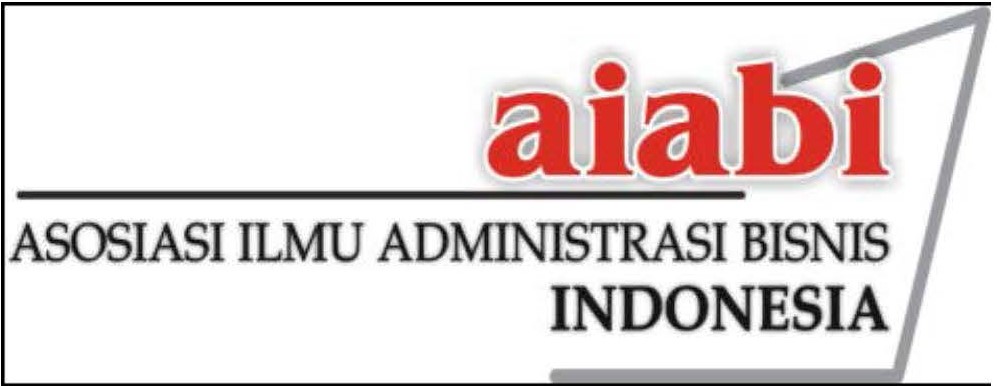STUDI EMPIRIS TERHADAP NILAI YANG DIRASAKAN DAN KEPUASAN PELANGGAN PADA RESTORAN CEPAT SAJI
Abstrak
The aim of this study was to determine the effect of food quality, quality of physical environment, and service quality on customer perceived value and customer satisfaction. This research was conducted in five KFC restaurant outlets located in Surabaya. A total of 200 customers were examined, but only 165 questionnaires were processed because 35 questionnaires were identified as outliers so that they were excluded from the research data. The results of this study indicate that the food qualtiy has significantly effects on the customer perceived value, however the quality of the physical environment has no significant effect on the customer perceived value. Furthermore, service quality has significant effect on the customer perceived value and the customer perceived value has significant effect on customer satisfaction.
Penelitian ini dilakukan dengan tujuan untuk mengetahui pengaruh kualitas makanan, kualitas lingkungan fisik, dan kualitas pelayanan terhadap nilai yang dipersepsikan pelanggan serta kepuasan pelanggan. Penelitian ini dilakukan di lima outlet restoran KFC yang berada di Surabaya. Sebanyak 200 pelanggan yang diteliti, namun hanya 165 kuesioner yang dapat diolah karena 35 kuesioner teridentifikasi sebagai outlier sehingga dikeluarkan dari data penelitian. Hasil penelitian ini menunjukkan bahwa kualitas makanan berpengaruh secara signifikan terhadap nilai yang dipersepsikan pelanggan. Sedangkan kualitas lingkungan fisik menunjukkan tidak berpengaruh secara signifikan terhadap nilai yang dipersepsikan pelanggan. Selanjutnya, kualitas pelayanan menunjukkan pengaruh yang signifikan terhadap nilai yang dipersepsikan pelanggan dan yang terakhir adalah nilai yang dipersepsikan pelanggan menunjukkan pengaruh yang signifikan terhadap kepuasan pelanggan.
Kata Kunci
Teks Lengkap:
PDFReferensi
Bitner, M.J., 1992, “Servicescapes: the impact of physical surroundings on customers and employees”, Journal of Marketing, Vol. 56, hlm. 57-71.
Bonjanic, D.C., 2007, “Customer profile of the “carryout” segment for restaurants”, International Journal of Contemporary Hospitality Management, Vol. 19 No. 1, hlm. 21-31.
Chen, P.T. dan Hu, H.H., 2010, “How determinant attributes of service quality influence customer-perceived value: an empirical investigation of the Australian coffee outlet industry”, International Journal of Contemporary Hospitality Management, Vol. 22 No. 4, hlm. 535-551.
Chow, I.H., Lau, V.P., Lo, T.Y., Sha, Z. dan Yun, H., 2007, “Service quality in restaurant operations in China: decision- and experiential-oriented perspectives”, International Journal of Hospitality Management, Vol. 26 No. 3, hlm. 698-710.
Cronin, J.J., Brady, M.K. dan Hult, G.T.M., 2000, “Assessing the effects of quality, value, and customer satisfaction on consumer behavioral intentions in service environments”, Journal of Retailing, Vol. 76 No. 2, hlm. 193-218.
Eggert, A. dan Ulaga, W., 2002, “Customer perceived value: a substitute for satisfaction in business markets”, The Journal of Business & Industrial Marketing, Vol. 17 No. 2/3, hlm. 107-118.
Fullerton, G., 2005, “The service quality-loyalty relationship in the retail services: does commitment matter?”, Journal of Retailing and Consumer Services, Vol. 12, hlm. 99-111.
Gardial, S.F., Clemons, D.S., Woodruff, R.B., Schumann, D.W. dan Burns, M.J., 1994, “Comparing consumers’ recall of prepurchase and postpurchase evaluation experiences”, Journal of Consumer Research, Vol. 20 No. 4, hlm. 548-560.
Gilbert, G.R., Veloutsou, C., Goode, M.M.H. dan Moutinho, L., 2004, “Measuring customer satisfaction in the fast food industry”, Journal of Service Marketing, Vol. 18 No. 5, hlm. 371-383.
Ha, J. dan Jang, S., 2010a, “Perceived values, satisfaction, and behavioral intentions: the role of familiarity in Korean restaurants”, International Journal of Hospitality Management, Vol. 29 No. 1, hlm. 2-13.
Ha, J. dan Jang, S., 2010b, “Effects of service quality and food quality: the moderating role of atmospherics in an ethnic restaurant segment”, International Journal of Hospitality Management, Vol. 29 No. 3, hlm. 520-529.
Ha, J. dan Jang, S., 2013, “Attributes, consequences, and consumer values: A means-end chain approach across restaurant segments”, Journal of Contemporary Hospitality Management Vol. 25 No. 3, 2013, hlm. 383-409.
Han, H. dan Ryu, K., 2007, “Moderating role of personal characteristics in forming restaurant customers’ behavioral intentions – an upscale restaurant setting”, Journal of Hospitality & Leisure Marketing, Vol. 15 No. 4, hlm. 25-54.
Han, H. dan Ryu, K., 2009, “The roles of the physical environment, price perception, and customer satisfaction in determining customer loyalty in the restaurant industry”, Journal of Hospitality and Tourism Research, Vol. 33 No. 4, hlm. 487-510.
Holbrook, M.B., 1999, “Introduction to Consumer Value in Consumer Value: A Framework for Analysis and Research”, Routledge, London, hlm. 1-28.
Jang, S. dan Namkung, Y., 2009, “Perceived quality, emotions, and behavioral intentions: application of an extended Mehrabian-Russell model to restaurants”, Journal of Business Research, Vol. 62 No. 4, hlm. 451-460.
Kivela, J.J., 1997, “Restaurant marketing: selection and segmentation in Hong Kong”, International Journal of Contemporary Hospitality Management, Vol. 9 No. 3, hlm. 116-123.
Knutson, B.J., 2000, “College students and fast food – how students perceive restaurant brands”, Cornell Hotel and Restaurant Administration Quarterly, Vol. 41 No. 3, hlm. 68-74.
Kwun, D.J. dan Oh, H., 2006, “Past experience and self-image in fine dining intentions”, Journal of Foodservice Business Research, Vol. 9 No. 4, hlm. 3-23.
Lin, Y., 2004, “Evaluating a servicescape: the effect of cognition and emotion”, International Journal of Hospitality management, Vol. 23 No. 2, hlm. 163-78.
Liu, Y. dan Jang, S., 2009a, “Perceptions of Chinese restaurants in the US: what affects customer satisfaction and behavioral intentions?”, International Journal of Hospitality Management, Vol. 28 No. 3, hlm. 338-348.
Liu, Y. H. dan Jang, S., 2009b, “The effects of dining atmospherics: an extended Mehrabian-Russell model”, International Journal of Hospitality Management, Vol. 28 No. 4, hlm. 494-503.
Lovelock, C. H. dan Wright, L. K., 2007, “Manajemen Pemasaran Jasa”, Indeks, Jakarta.
Mattila, A.S., 1999, “An analysis of means-end hierarchies in cross-cultural contest: what motivates Asian and Western business travelers to stay at luxury hotels?”, Journal of Hospitality & Leisure Marketing, Vol. 6 No. 2, hlm. 19-28.
McCleary, K.W., Lattimer, C.L., Clemenz, C.E. dan Weaver, P.A., 2008, “From Broadway to the bistro: partnering with the arts to attract upscale customers”, International Journal of Hospitality Management, Vol. 27 No. 2, hlm. 197-203.
Namkung, Y. dan Jang, S., 2008, “Are highly satisfied restaurant customers really different? A quality perception perspective”, International Journal of Contemporary Hospitality Management, Vol. 20 No. 2, hlm. 142-155.
Nguyen, N. dan Leblanc, G., 2002, “Contact personnel, physical environment and the perceived corporate image of intangible services by new clients”, International Journal of Service Industry Management, Vol. 13 No. 3, hlm. 242-262.
Parasuraman, A., 1997, “Reflections on gaining competitive advantage through customer value”, Journal of the Academy of Marketing Science, Vol. 25 No. 2, hlm. 154-161.
Park, C., 2004, “Efficient or enjoyable? Consumer values of eating-out and fast food restaurant consumption in Korea”, International Journal of Hospitality Management, Vol. 23 No. 1, hlm. 87-94.
Pettijohn, L. S., Pettijohn, C. E., dan Luke, R. H., 1997, “An evaluation of fast food restaurant satisfaction: determinants, competitive comparisons and impacts on future patronage”, Journal of Restaurant and Foodservice Marketing, Vol 2 No. 3, hlm. 3-20.
Reynolds, T. dan Gutman, J., 1988, “Laddering theory, method, analysis, and interpretation”, Journal of Advertising Research, Vol. 28 No. 1, hlm. 11-31.
Ryu, K. dan Han, H., 2010, “Influence of the quality of food, service, and physical environment on customer satisfaction in quick-casual restaurants: moderating role of perceived price”, Journal of Hospitality & Tourism Research, Vol. 34 No. 3, hlm. 310-329.
Ryu, K. dan Jang, S., 2007, “The effect of environmental perceptions on behavioral intentions through emotions: the case of upscale restaurants”, Journal of Hospitality and Tourism Research, Vol. 31 No. 1, hlm. 56-72.
Ryu, K. dan Jang, S., 2008a, “DINESCAPE: a scale for customers’ perception of dining environments”, Journal of Foodservice Business Research, Vol. 11 No. 1, hlm. 2-22.
Ryu, K. dan Jang, S., 2008b, “Influence of restaurant’s physical environments on emotion and behavioral intention”, Service Industries Journal, Vol. 28 No. 8, hlm. 1151-1165.
Ryu, K., Lee, H-R., dan Kim., W. G., 2012, “The influence of the quality of the physical environment, food, and service on restaurant image, customer perceived value, customer satisfaction, and behavioral intentions”, Journal of Contemporary Hospitality Management, Vol. 24 No. 2, hlm. 200-223.
Santoso, S., 2012, Analisis SEM Menggunakan AMOS, PT Elex Media Komputindo, Jakarta.
Wakefield, K.L. dan Blodgett, J.G., 1994, “The importance of servicescapes in leisure service settings”, Journal of Services Marketing, Vol. 8 No. 3, hlm. 66-76.
Weiss, R., Feinstein, A.H. dan Dalbor, M., 2004, “Customer satisfaction of theme restaurant attributes and their influence on return intention”, Journal of Foodservice Business Research, Vol. 7 No. 1, hlm. 23-39.
Woodruff, R.B., 1997, “Customer value: the next source for competitive advantage”, Journal of the Academy of Marketing Science, Vol. 25 No. 2, hlm. 139-53.
Zeithaml, V., Berry, L.L. dan Parasuraman, A., 1996, “The behavioral consequences of service quality”, Journal of Marketing, Vol. 60 No. 2, hlm. 31-46.
DOI: https://doi.org/10.24198/adbispreneur.v3i3.19122
Refbacks
- Saat ini tidak ada refbacks.









